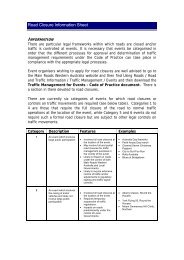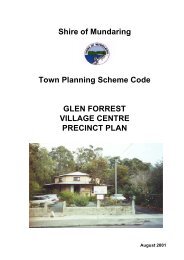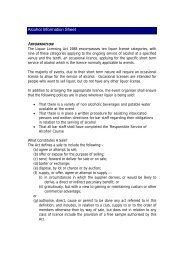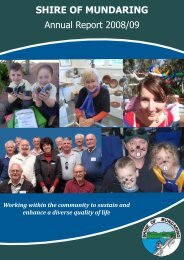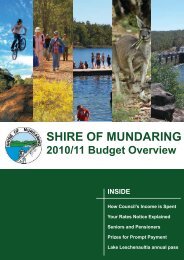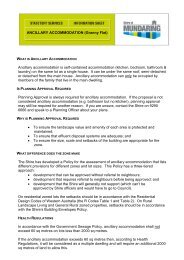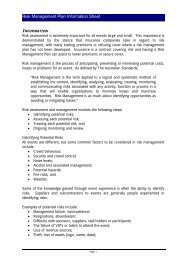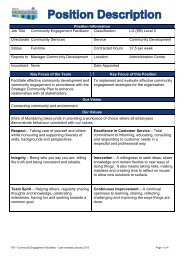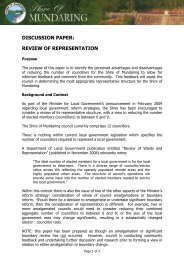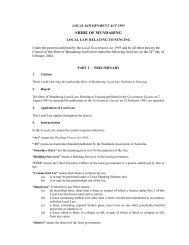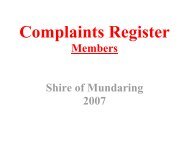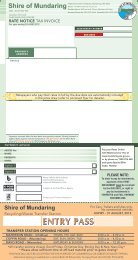fire burning information shire of mundaring
fire burning information shire of mundaring
fire burning information shire of mundaring
You also want an ePaper? Increase the reach of your titles
YUMPU automatically turns print PDFs into web optimized ePapers that Google loves.
SHIRE OF MUNDARING<br />
FIRE<br />
BURNING<br />
INFORMATION<br />
2010-2011<br />
PERMITS TO BURN ARE REqUIRED<br />
CAUTION DATes sUbjeCT TO seAsONAl ChANges<br />
OctOber 1st tO NOvemebr 30th (iNclusive) - April 1st tO mAY 31st (Nclusive)<br />
RING<br />
to report all <strong>fire</strong>s
Dear resident,<br />
FORWARD<br />
it is hoped that <strong>information</strong> in this document will help you to<br />
prepare your property to a standard, which will protect you and<br />
your neighbours from damaging bush <strong>fire</strong>s. the document outlines<br />
strategies to prepare for the <strong>fire</strong> season and to assist you to meet<br />
the conditions, which are required by legislation.<br />
preparing for <strong>fire</strong> is the responsibility <strong>of</strong> every resident, and if each<br />
member <strong>of</strong> the community maintains a proper level <strong>of</strong> preparedness,<br />
the threat <strong>of</strong> bush <strong>fire</strong> will be greatly minimized.<br />
many members <strong>of</strong> the community make themselves available to<br />
respond to threats through their membership <strong>of</strong> the volunteer<br />
Fire brigades and state emergency service units. the <strong>shire</strong> <strong>of</strong><br />
<strong>mundaring</strong> supports these organisations. Your efforts in preparing<br />
your property will enhance the effectiveness <strong>of</strong> the volunteer<br />
brigades should a <strong>fire</strong> occur.<br />
Your feedback on the <strong>information</strong> in this document would also be<br />
welcome. You could send your comments by post or email, or<br />
simply call community safety on 9290 6666.<br />
Jonathan throssell<br />
chieF eXecutive OFFicer
1<br />
INDEX<br />
CALENDAR OF BURNING RESTRICTIONS ................................................. 1<br />
BURNING PERIOD DATES 2009/2010 ...................................................... 2<br />
FIRE DANGER RATING ............................................................................. 2<br />
FIREBREAK NOTICE ................................................................................ 3<br />
BUILDING PROTECTION ZONE ................................................................. 6<br />
FIRE HAZARDS ....................................................................................... 6<br />
PERMITS TO BURN ................................................................................. 7<br />
STACKS OR PILES OF VEGETATION.......................................................... 7<br />
INCINERATORS ....................................................................................... 7<br />
OUTDOOR COOKING ............................................................................... 8<br />
WELDING/CUTTING/GRINDING ............................................................... 8<br />
VEHICLE AND MACHINERY OPERATIONS ................................................. 8<br />
TOTAL FIRE BAN ..................................................................................... 9<br />
BURNING OF GARDEN REFUSE ................................................................ 9<br />
WHEN BURNING IS PERMITTED ............................................................. 10<br />
ALTERNATIVES TO BURNING ................................................................. 11<br />
PREPARE. ACT. SURVIVE. ..................................................................... 12<br />
PREPARE FOR FIRES ............................................................................. 13<br />
PREPARE YOUR SURVIVAL KIT .............................................................. 14<br />
ENHANCE YOUR PROPERTY PROTECTION ............................................. 14<br />
FIRE DANGER INDEX ............................................................................. 15<br />
VOLUNTEER FIRE BRIGADES ................................................................. 17<br />
CONTACT NUMBERS ............................................................................. 18<br />
CALENDAR OF BURNING RESTRICTIONS<br />
PROHIBITED NO FIRES<br />
DEC JAN FEB MAR<br />
RESTRICTED<br />
PERMITS NEEDED<br />
APR MAY JUN JUL<br />
RESTRICTED<br />
PERMITS NEEDED<br />
AUG SEP OCT NOV<br />
These dates may vary due to seasonal conditions<br />
If in doubt - call the Shire <strong>of</strong> Mundaring
BURNING PERIOD DATES 2010/2011<br />
These dates may vary due to seasonal conditions<br />
RESTRICTED BURNING PERIOD 1<br />
October 1st to November 30th (inclusive)<br />
permits to burn are required for all <strong>burning</strong> during this period.<br />
Note that small amounts <strong>of</strong> garden refuse may be burnt without a permit after 6 pm, see conditions<br />
PROHIBITED BURNING PERIOD<br />
December 1st to March 31st (inclusive)<br />
All <strong>burning</strong>, including garden refuse is prohibited during this period<br />
RESTRICTED BURNING PERIOD 2<br />
April 1st to May 31st (inclusive)<br />
permits to burn are required for all <strong>burning</strong> during this period.<br />
Note that small amounts <strong>of</strong> garden refuse may be burnt without a permit after 6 pm, see conditions<br />
IMPORTANT NOTES<br />
• Climate or weather conditions may cause these periods to be varied.<br />
Period variations will be advertised in local papers and also on the<br />
Shire <strong>of</strong> Mundaring website.<br />
• Permits to burn may ONLY be obtained from your local Volunteer Fire Station.<br />
locations and contact detail are at the rear <strong>of</strong> this booklet.<br />
• ALL <strong>burning</strong> is prohibited on <strong>fire</strong> danger rating days <strong>of</strong> Very High or above.<br />
FIRE DANGER RATING<br />
No <strong>fire</strong> <strong>of</strong> any kind may be lit on a day when the forecast Fire Danger rating<br />
for the District is very high or above.<br />
the <strong>fire</strong> danger rating is supplied daily by the bureau <strong>of</strong> meteorology.<br />
this <strong>information</strong> is available on the <strong>shire</strong>s <strong>information</strong> hotline 9290 6644 and is<br />
also displayed on the <strong>information</strong> boards located at (1) Great eastern highway<br />
at the top <strong>of</strong> Greenmount hill ,(2) Great eastern highway east <strong>of</strong> the <strong>mundaring</strong><br />
light industrial area and (3) stoneville road/riley road intersection, stoneville.<br />
this <strong>information</strong> is also available from the telstra Weather service by dialling<br />
1196 and also from the bureau <strong>of</strong> meteorology website (www.bom.gov.au)<br />
the <strong>mundaring</strong> <strong>fire</strong> weather district is lower West inland.<br />
2
3<br />
FIREBREAK NOTICE<br />
Bush Fires Act 1954<br />
Shire <strong>of</strong> Mundaring<br />
Notice to All Owners And/Or Occupiers Of land<br />
situated in the <strong>shire</strong> Of <strong>mundaring</strong>.<br />
As a measure to assist in the control <strong>of</strong> bush <strong>fire</strong>s, or preventing the spread or<br />
extension <strong>of</strong> a bush <strong>fire</strong> which may occur, all owners and occupiers <strong>of</strong> land within<br />
the <strong>shire</strong>’s district are required before the 1st day <strong>of</strong> December in each year, or<br />
within 14 days <strong>of</strong> becoming the owner or occupier <strong>of</strong> land if after that date, to clear<br />
<strong>fire</strong>breaks or take measures in accordance with this notice and maintain those<br />
<strong>fire</strong>breaks and measures in accordance with this notice up to and including the 31st<br />
day <strong>of</strong> march in the following year.<br />
pursuant to the powers contained in section 33 <strong>of</strong> the bush Fires Act 1954, you<br />
are hereby required to clear <strong>of</strong> flammable material <strong>fire</strong>breaks not less than 3 metres<br />
in width, and 4 metres in height, immediately inside all external boundaries <strong>of</strong> any<br />
lot owned or occupied by you and situated within the <strong>shire</strong> <strong>of</strong> <strong>mundaring</strong>. such<br />
<strong>fire</strong>breaks may be constructed by one or more <strong>of</strong> the following methods:<br />
plOuGhiNG, cultivAtiNG, scAriFYiNG, rAKiNG, burNiNG, chemicAl sprAYiNG<br />
Or Other ApprOveD methOD,<br />
the following land categories are to be cleared and maintained to the satisfaction <strong>of</strong><br />
an Authorised Officer <strong>of</strong> the <strong>shire</strong>.<br />
1. All land zoned Residential with a building on it.<br />
• Maintain all grass on the land to a height no greater than 5cm.<br />
• Prune trees and shrubs, and remove dead flammable material around all<br />
structures to provide a building protection zone.<br />
• Ensure the ro<strong>of</strong>s, gutters and walls <strong>of</strong> all buildings on the land are free <strong>of</strong><br />
flammable matter.<br />
On any lot having an area <strong>of</strong> less than 4,000m² with a dwelling constructed on<br />
it, where the lot is substantially developed (i.e. at least 75% cleared <strong>of</strong> natural<br />
vegetation), the keeping <strong>of</strong> grass on the lot at all times covered by this notice to a<br />
height less than 5 centimetres will be accepted in lieu <strong>of</strong> clearing a <strong>fire</strong>break. For<br />
the purpose <strong>of</strong> section 1 grass kept at a height <strong>of</strong> less than 5 centimetres will be<br />
deemed not to be flammable material.<br />
2. All vacant land zoned Residential.<br />
• Maintain all grass and dead flammable matter on the land to a height no<br />
greater than 5cm.<br />
• Install a 3 metre wide <strong>fire</strong>break immediately inside all external boundaries <strong>of</strong><br />
the land by removing all flammable matter within that 3 metre wide <strong>fire</strong>break<br />
to a height <strong>of</strong> 4 metres.
3. All land zoned other than Residential, with a building on it.<br />
• Maintain all grass and clear dead flammable matter on the land to a height<br />
no greater than 5cm.<br />
• Install a 3 metre wide <strong>fire</strong>break around all structures and immediately inside<br />
all external boundaries <strong>of</strong> the land by removing all flammable matter within<br />
that 3 metre wide <strong>fire</strong>break to a height <strong>of</strong> 4 metres.<br />
• Prune trees and shrubs, and remove dead flammable material around all<br />
structures to provide a building protection zone.<br />
• Ensure the ro<strong>of</strong>s, gutters and walls <strong>of</strong> all buildings on the land are free <strong>of</strong><br />
flammable matter.<br />
• Maintain fuel loadings in natural bush areas at less than 8 tonnes per hectare<br />
across the land.<br />
Note: On average, leaf litter accumulates at approximately 1 tonne per hectare<br />
per year.<br />
4. All vacant land zoned other than Residential.<br />
• Maintain all grass on the land to a height no greater than 5cm.<br />
• Install a 3 metre wide <strong>fire</strong>break immediately inside all external boundaries<br />
<strong>of</strong> the land and within 20 metres <strong>of</strong> any haystacks or stockpiled flammable<br />
material, by removing all flammable matter within that 3 metre wide <strong>fire</strong>break<br />
to a height <strong>of</strong> 4 metres.<br />
• Maintain fuel loadings in natural bush areas at less than 8 tonnes per hectare<br />
across the land.<br />
Note: On average, leaf litter accumulates at approximately 1 tonne per hectare<br />
per year.<br />
(For the definition <strong>of</strong> flammable material and Building Protection Zone please refer to<br />
the Shire <strong>of</strong> Mundaring Fire and Burning Information Booklet.)<br />
5. Livestock<br />
if the land is stocked, the livestock must graze the grass down so that the grass is<br />
no greater than 5cm high prior to the end <strong>of</strong> December <strong>of</strong> that year.<br />
6. Fuel Dumps and Depots.<br />
remove all inflammable matter within 10 metres <strong>of</strong> where fuel drums, fuel ramps or<br />
fuel dumps are located, and where fuel drums, whether containing fuel or not, are<br />
stored.<br />
7. Application to vary the above requirements.<br />
if it is considered impracticable for any reason whatsoever to clear <strong>fire</strong>breaks or<br />
establish other arrangements as required by this notice, you may apply in writing<br />
to the <strong>shire</strong> <strong>of</strong> <strong>mundaring</strong> not later than the 15th day <strong>of</strong> November each year for<br />
permission to provide <strong>fire</strong>breaks in alternative positions on the land. if permission<br />
4
5<br />
is not granted in writing by the <strong>shire</strong> you must comply with the requirements <strong>of</strong> this<br />
notice.<br />
in addition, you may be required to carry out further works which are considered<br />
necessary by an Authorised Officer <strong>of</strong> the <strong>shire</strong> and specified by way <strong>of</strong> a separate<br />
written notice forwarded to the address as shown on the <strong>shire</strong> <strong>of</strong> <strong>mundaring</strong> rates<br />
record for the relevant land.<br />
tAKe NOtice that pursuant to section 33(4) <strong>of</strong> the bush Fires Act, where the owner<br />
or occupier <strong>of</strong> land who has received notice fails or neglects to comply with the<br />
requisitions <strong>of</strong> the notice within the time specified, the <strong>shire</strong> <strong>of</strong> <strong>mundaring</strong> may by its<br />
<strong>of</strong>ficers and with such servants, workmen and contractors, vehicles and machinery<br />
as the <strong>of</strong>ficers deem fit, enter upon the land and carry out the requisitions <strong>of</strong> the<br />
notice which have not been complied with and pursuant to section 33(5) <strong>of</strong> the bush<br />
Fires Act the amount <strong>of</strong> any costs and expenses incurred may be recovered from<br />
you as the owner or occupier <strong>of</strong> the land.<br />
All <strong>fire</strong>breaks and other alternative arrangements allowed by the preceding parts <strong>of</strong><br />
this notice must be established by the 30th day <strong>of</strong> November each year (or within<br />
14 days <strong>of</strong> you becoming the owner or occupier should this occur after that date)<br />
and maintained clear <strong>of</strong> flammable material up to and including the 31st day <strong>of</strong><br />
march each year.<br />
if the requirements <strong>of</strong> this notice are carried out by <strong>burning</strong>, such <strong>burning</strong> must be in<br />
accordance with the relevant provisions <strong>of</strong> the bush Fires Act.<br />
the peNAltY FOr FAiliNG tO cOmplY with this notice is a fine not exceeding<br />
$5,000 and a person in default is also liable whether prosecuted or not to pay the<br />
costs <strong>of</strong> performing the work directed by this notice if it is not carried out by the<br />
owner and/or occupier by the date required by this notice.<br />
by order <strong>of</strong> the council<br />
Jonathan throssell<br />
chief executive Officer
BUILDING PROTECTION ZONE<br />
buildings should be protected by a building protection zone that meets the following<br />
requirements:<br />
• Width: 20 metres measured from any external wall <strong>of</strong> the building<br />
• Location: within the boundaries <strong>of</strong> the lot on which the building is situated<br />
• Fuel load: reduced to and maintained at less than 2 tonnes per hectare<br />
• Trees (crowns) are a minimum <strong>of</strong> 10 metres apart<br />
• Trees are low pruned to a height <strong>of</strong> 2 metres at least<br />
• No tall shrub or tree is located within 2 metres <strong>of</strong> a building (including windows)<br />
• There are no tree crowns overhanging the building<br />
• Fences and sheds within the building protection zone are constructed using non<br />
combustible materials (eg colorbond iron, brick, limestone)<br />
• Shrubs in the building protection zone have no dead material within the plant<br />
• Tall shrubs within the building protection zone are not planted in clumps close to<br />
the building ie within 3 metres<br />
• Trees in the building protection zone have no dead material within the plant’s<br />
crown or on the bole<br />
Notes to above: to measure and determine fuel loads use FESA’s Visual Fuel<br />
Load Guide available from Shire <strong>of</strong> Mundaring or FESA.<br />
Surface bush <strong>fire</strong> fuels should be kept low to the ground. Potential bush <strong>fire</strong> fuels<br />
should be kept green if possible<br />
FIRE HAZARDS<br />
it is the responsibility <strong>of</strong> the land owner to control <strong>fire</strong> hazards including;<br />
• The provision <strong>of</strong> adequate <strong>fire</strong> breaks.<br />
the Fire breaks and Driveways must allow unrestricted access free <strong>of</strong><br />
obstructions and be suitable for emergency vehicle use.<br />
in some instances, naturally occurring features such as rock outcrops,<br />
watercourses or landscaping such as reticulated gardens, lawns or driveways<br />
may be an acceptable substitute for cleared <strong>fire</strong>breaks. this option must be<br />
approved in writing by an authorized <strong>of</strong>ficer <strong>of</strong> the <strong>shire</strong> <strong>of</strong> <strong>mundaring</strong> prior to 15<br />
November.<br />
• Slash all standing grass and maintain dead flammable matter such as leaves,<br />
twigs, bark etc to a height <strong>of</strong> not more than 5cm.<br />
• Ensure native bush is <strong>fire</strong> safe and ensure that bush fuel loads are not excessive.<br />
Bush fuel loads should not exceed 8 tonnes per hectare.<br />
As a guide, bush litter will accumulate at a rate <strong>of</strong> about 1 tonne per hectare per<br />
year.<br />
• Ensure that all inflammable fuels are stored safely and well clear <strong>of</strong> all buildings.<br />
6
7<br />
council is authorised to engage private contractors to carry out required <strong>fire</strong><br />
hazard reduction work at the land owner’s expense if you have failed to ensure your<br />
property is <strong>fire</strong> safe.<br />
Flammable material is All combustible material, dead or alive, that may be likely<br />
to fuel a bush <strong>fire</strong>. it includes, but is not limited to, dead leaves, fallen branches, dry<br />
grass, bracken or any other combustible material. it does not include areas such<br />
as vegetable patches, tended lawn, landscaped gardens (including deciduous or<br />
ornamental planted trees) that in the opinion <strong>of</strong> an authorised Fire control Officer do<br />
not constitute a <strong>fire</strong> risk.<br />
it also includes any tree or branch that may create a <strong>fire</strong> hazard by falling onto a<br />
building.<br />
PERMITS TO BURN<br />
permits are required to burn bush or grass at any time during the restricted <strong>burning</strong><br />
period. (see also “When <strong>burning</strong> is permitted”).<br />
permits are only available from the volunteer bush Fire brigade in your district (note<br />
brigades can not issue permits for districts other than their own).<br />
the times and contact details for permits can be found in the rear <strong>of</strong> this booklet.<br />
the conditions for the <strong>burning</strong> <strong>of</strong> small quantities <strong>of</strong> garden rubbish without a permit<br />
after 6 pm are explained in this book, (see <strong>burning</strong> <strong>of</strong> Garden rubbish).<br />
STACKS OR PILES OF VEGETATION<br />
the Department <strong>of</strong> environment and conservation (Dec) prohibits the <strong>burning</strong> <strong>of</strong><br />
vegetation on or from a development site where the area cleared is greater than<br />
2000 sqm. this includes residential and construction lots. such vegetation must be<br />
mulched or removed from the site and must NOt be burnt on site.<br />
INCINERATORS<br />
incinerators must not be lit during the prohibited <strong>burning</strong> period or on any day when<br />
a total Fire ban has been declared.<br />
incinerators must not be lit if the Fire Danger rating is very high or above.<br />
During the restricted <strong>burning</strong> period, incinerators may only be lit from 6 pm till 11<br />
pm.<br />
incinerators must be properly constructed and designed to prevent the escape <strong>of</strong><br />
any sparks or <strong>burning</strong> material. they must be located at least 2 metres away from<br />
any building or fence and all flammable material.<br />
household garbage or materials such as plastic and rubber which cause noxious<br />
smoke must not be burnt in incinerators. smoke from incinerators must not cause a<br />
nuisance to other residents.
OUTDOOR COOKING<br />
Gas or electric barbecues are permitted at any time.<br />
solid fuel barbecues, spit roasts, Webbers, pizza ovens and any other cooking <strong>fire</strong>s<br />
are permitted at home, if the <strong>fire</strong>place is properly constructed so as to prevent the<br />
escape <strong>of</strong> any sparks or <strong>burning</strong> material and is surrounded by a 3 metre fuel free<br />
zone.<br />
A person must be in attendance at all times and a method <strong>of</strong> <strong>fire</strong> suppression such<br />
as a hose must be on hand.<br />
solid Fuel cooking Fires MUST NOT BE LIT on days <strong>of</strong> very high or above <strong>fire</strong><br />
danger rating or on any day when a total Fire ban has been declared.<br />
many recreation sites within the <strong>shire</strong> <strong>of</strong> <strong>mundaring</strong> have gas or electric barbecues<br />
installed which may be used at any time<br />
WELDING/CUTTING/GRINDING<br />
if you are using a welder(oxy-acetylene or arc), or gas flame for heating or cutting<br />
or operating a power operated abrasive cutting or grinding disc <strong>of</strong> any kind, you<br />
must have at least one <strong>fire</strong> extinguisher present and be surrounded by a five metre<br />
cleared area. Your local Fire control Officer or other authorized <strong>of</strong>ficer <strong>of</strong> the <strong>shire</strong><br />
may impose additional conditions.<br />
extreme care should be exercised to prevent sparks from igniting dry grass/leaves<br />
etc.<br />
All hot work operations are prohibited on any day when a total Fire ban has been<br />
declared.<br />
VEHICLE AND MACHINERY OPERATIONS<br />
the operation <strong>of</strong> vehicles and farm machines may create a bush <strong>fire</strong> risk.<br />
• Farm machines should be kept clean <strong>of</strong> dust and vegetation.<br />
• Fit spark arrestors to machinery exhausts.<br />
• Check the underside <strong>of</strong> farm vehicles and machinery for any build up <strong>of</strong> straw or<br />
vegetation, particularly around exhaust systems and catalytic converters.<br />
• Carry appropriate <strong>fire</strong> extinguishers that meet the requirements <strong>of</strong> the Bush Fires<br />
Act 1954.<br />
• Vehicle and Machinery exhaust pipes must meet the requirements set out in<br />
the bush Fires Act 1954 if they are to be operated during the restricted or<br />
prohibited <strong>burning</strong> periods.<br />
8
9<br />
TOTAL FIRE BANS<br />
total Fire bans are declared at times <strong>of</strong> extreme weather conditions or when<br />
widespread <strong>fire</strong>s are seriously stretching resources.<br />
they are declared on days where <strong>fire</strong>s are most likely to threaten lives and property<br />
and consider local conditions such as how moist the soil is or the amount <strong>of</strong> trees<br />
and bush in an area that could burn during a <strong>fire</strong>.<br />
When a total Fire ban is declared it is illegal to do anything that is likely to start a<br />
<strong>fire</strong>.<br />
that means if you live in a <strong>shire</strong> where a total Fire ban is in place you MUST NOT:<br />
• cook outside using an open <strong>fire</strong><br />
• move vehicles or equipment across a paddock<br />
• harvest<br />
• undertake ‘hot work’ such as metal work, grinding or the like unless you have an<br />
exemption<br />
During a total Fire ban you will still be able to:<br />
• use a gas cooker or barbecue with an enclosed flame or an electrical stove at<br />
home or in a designated area. many recreation sites within local government<br />
areas have gas or electric barbecues installed, which may be used at any time<br />
• undertake essential feeding and watering <strong>of</strong> your stock (by exemption permit)<br />
• use a chainsaw, plant or grass trimmer or lawn mower but it is best to postpone<br />
this work as it could still start a <strong>fire</strong><br />
• smoke but you must put out your cigarettes or cigars properly and safely<br />
dispose <strong>of</strong> the butt<br />
• undertake any work covered by a current exemption as long as you meet any<br />
special conditions that apply.<br />
You could be fined up to $25 000 or jailed for 12 months or both if you ignore the<br />
total Fire ban.<br />
An exemption may be granted if you can show you are taking proper steps to<br />
prevent any <strong>fire</strong> spreading and can control and put out any <strong>fire</strong> that might start.<br />
exemptions can cover specific times and locations and can be changed or cancelled<br />
at any time.<br />
BURNING OF GARDEN REFUSE<br />
Garden refuse must not be burnt at any time during the prohibited <strong>burning</strong> period or<br />
on any day when a total Fire ban has been declared.<br />
A permit is required to burn garden refuse before 6pm during the restricted<br />
<strong>burning</strong> periods, and is subject to the conditions as set out on the permit.<br />
Garden refuse may be burnt without a permit after 6pm during the restricted<br />
<strong>burning</strong> periods, subject to the following conditions <strong>of</strong> the bush Fire Act 1954 and<br />
the health Act 1911.
• The pile <strong>of</strong> refuse being burnt does not exceed 1 cubic metre.<br />
• A 5 metre wide area clear <strong>of</strong> flammable material surrounds the pile. (Lawn,<br />
paths, Driveways, etc. may be considered as cleared area).<br />
• The <strong>fire</strong> is only lit between 6:00 p.m. and 11:00 p.m.<br />
• Only 1 pile is alight at one time.<br />
• The <strong>fire</strong> is completely extinguished by midnight.<br />
• At least 1 person is in attendance at all times.<br />
• There is a means <strong>of</strong> extinguishing the <strong>fire</strong> available at all times. (e.g. garden<br />
hose, knapsack spray or <strong>fire</strong> unit).<br />
• You notify your neighbours <strong>of</strong> your intention to burn.<br />
• The Fire Danger Rating is not Very High or above.<br />
• The smoke from your <strong>fire</strong> does not cause a nuisance to neighbours.<br />
• The smoke from your <strong>fire</strong> does not create a traffic hazard.<br />
• Do not burn household or commercial waste or any noxious materials.<br />
• Do not burn damp, wet or green material at any time as this will cause excessive<br />
smoke.<br />
Other than during the restricted or prohibited periods, garden refuse may be burnt<br />
at any time, but care must be exercised.<br />
Smoke from the <strong>burning</strong> <strong>of</strong> garden rubbish can cause nuisance and<br />
annoyance to other residents. Please consider this and plan to minimise<br />
smoke.<br />
WHEN BURNING IS PERMITTED<br />
(See also <strong>burning</strong> <strong>of</strong> Garden Refuse)<br />
During the restricted <strong>burning</strong> seasons, a permit must first be obtained from your<br />
local volunteer bush Fire brigade before you can burn on your property. permits will<br />
stipulate times and other conditions which must be adhered to.<br />
NO BURNING is to be conducted on any day when the forecast Fire Danger rating<br />
is very high or above.<br />
NO BURNING may be conducted during the prohibited <strong>burning</strong> period or on any<br />
day when a total Fire ban has been declared.<br />
<strong>burning</strong> to reduce the amount <strong>of</strong> fuel on a property is permitted without a permit<br />
only at those times outside <strong>of</strong> the restricted or prohibited <strong>burning</strong> season.<br />
plan the burn and apply for the permit well in advance. this will give you the<br />
opportunity to select the best conditions.<br />
Obtaining a permit outside the times specified in this book may be difficult as<br />
permits are issued by volunteers from your local Fire station which is not normally<br />
staffed.<br />
10
11<br />
When planning your burn, allow plenty <strong>of</strong> time and adequate resources to burn<br />
effectively and without undue rush or stress. Do not attempt to burn areas which<br />
will be difficult to control.<br />
Fires will be extremely difficult to control in strong winds.<br />
All planned <strong>burning</strong> activity should be deferred if the winds are expected to be<br />
above 10 km/hr. (definition <strong>of</strong> this is when leaves and twigs on trees are in constant<br />
motion).<br />
check the weather forecast before <strong>burning</strong>.<br />
Guidelines and advice to assist in Winter <strong>burning</strong> may be obtained from the <strong>shire</strong> <strong>of</strong><br />
<strong>mundaring</strong> <strong>of</strong>fice or from your local volunteer bush<strong>fire</strong> brigade.<br />
Your local volunteer Fire brigade may be able to conduct a burn on your behalf or<br />
give advice on how to burn. contact details for local brigades are included at the<br />
back <strong>of</strong> this booklet.<br />
SAFETY<br />
Obtaining a permit does not remove the responsibility to conduct the <strong>burning</strong> in<br />
a safe manner and does not remove the liability should the <strong>fire</strong> escape or cause<br />
damage.<br />
ALTERNATIVES TO BURNING<br />
there are a range <strong>of</strong> alternatives to <strong>burning</strong> waste which will not harm the<br />
environment and will not cause health problems for you or your neighbours.<br />
Grass can be slashed, grazed or reduced with herbicide to reduce fuel loads. this<br />
may be a practical alternative particularly if erosion is a concern or in areas which<br />
are difficult to access.<br />
ratepayers and residents in the <strong>shire</strong> <strong>of</strong> <strong>mundaring</strong> are able to dispose <strong>of</strong> their<br />
green waste and garden refuse free <strong>of</strong> charge at the Waste transfer stations:<br />
coppin road, mathieson road or mayo road. Green waste can also be disposed<br />
<strong>of</strong> at the red hill Waste Disposal Facility (toodyay road, Gidgegannup), however<br />
charges apply (ph: 9574 6235).<br />
the green waste material collected at the Waste transfer stations is mulched and<br />
sold commercially as garden mulch and compost.<br />
Garden refuse (particularly grass clippings, leaves and twigs) can also be used as a<br />
mulch or compost in the garden to improve soils and the growth <strong>of</strong> plants.<br />
if you have large quantities <strong>of</strong> green waste (branches, tree trunks) you can arrange<br />
for mobile mulching services to mulch the material on-site.<br />
mulching and composting at home avoids the need to burn <strong>of</strong>f and is an<br />
environmentally friendly way to deal with green waste. For further <strong>information</strong><br />
regarding composting, please contact the <strong>shire</strong> <strong>of</strong> <strong>mundaring</strong> on tel 9290 6666.<br />
mulch piles should be no larger than 5 cubic metres to reduce the risk <strong>of</strong><br />
spontaneous combustion and piles should have a <strong>fire</strong>break surrounding the pile.
PREPARE. ACT. SURVIVE.<br />
PREPARE. preparing yourself, your family and your home is your responsibility. the<br />
more that you prepare your home, the better the chance that it will survive a <strong>fire</strong>,<br />
even if you have left well before the <strong>fire</strong> because your plan is to leave.<br />
ACT. bush<strong>fire</strong>s can start suddenly so you need to be prepared to act even if you do<br />
not receive a warning. During hot weather you should know what the Fire Danger<br />
rating for your area is, watch for signs <strong>of</strong> bush<strong>fire</strong> and have your survival plan and<br />
kit ready.<br />
SURVIVE. During a bush<strong>fire</strong> the safest place to be is away from the <strong>fire</strong>. being<br />
involved in a <strong>fire</strong> may be one <strong>of</strong> the most traumatic experiences <strong>of</strong> your life.<br />
Bush<strong>fire</strong> Warning System.<br />
During a bush<strong>fire</strong> emergency services will provide as much <strong>information</strong> to you as<br />
possible through a number <strong>of</strong> different channels.<br />
there are three levels <strong>of</strong> warning. these may change to reflect the increasing risk to<br />
life and the decreasing time until the <strong>fire</strong> is expected to arrive.<br />
An ADVICE will provide you with <strong>information</strong> on a bush<strong>fire</strong> that is not threatening<br />
lives or property but may be causing smoke near homes.<br />
A WATCH AND ACT message will be issued when there is a potential for lives<br />
and property to be threatened. these messages will update you on the changing<br />
conditions and tell you to start taking action to protect yourself and your family.<br />
An EMERGENCY WARNING means you need to take immediate action to survive.<br />
this message may or may not start with an alert sound called the standard<br />
emergency Warning signal (seWs).<br />
STATE ALERT bush Fire Warnings may be issued by state Alert to telephones<br />
registered to each area. For further <strong>information</strong> or to register additional telephones<br />
visit the website www.statealert.wa.gov.au<br />
<strong>information</strong> on large incidents within the <strong>shire</strong> <strong>of</strong> <strong>mundaring</strong> can be obtained from;<br />
• The FESA web site (www.fesa.wa.gov.au)<br />
• The ABC local radio station. (6WF 720 AM) at 30 minute intervals.<br />
• The FESA emergency <strong>information</strong> telephone service 1300 657 209.<br />
Developing a bush Fire survival plan is critical. Your plan must be prepared and<br />
practiced with all members <strong>of</strong> your family or household before the start <strong>of</strong> the<br />
bush<strong>fire</strong> season.<br />
in making your plan you will need to consider;<br />
• Is your home defendable.,<br />
• Is it in a location that makes it difficult or dangerous to actively defend?<br />
• Who may be home if a bush<strong>fire</strong> occurs?<br />
• If your household includes elderly, young, people with disabilities or illness,<br />
consider, can these people be re located?<br />
Additional <strong>information</strong> including templates and checklists to help you prepare your<br />
bush<strong>fire</strong> survival plan are included in the booklet “PREPARE, ACT, SURVIVE”.<br />
12
13<br />
PREPARE FOR FIRES<br />
preparing for <strong>fire</strong>s is essential to living in our <strong>fire</strong> prone landscape. having a plan is<br />
the primary step to ensuring the survivability <strong>of</strong> your property and the welfare <strong>of</strong> you<br />
and your family.<br />
prepare your property thoroughly well before the <strong>fire</strong> season. it will be too late<br />
to prepare when a serious <strong>fire</strong> is threatening. Fuel loads influence the bush <strong>fire</strong><br />
intensity. if the intensity <strong>of</strong> the <strong>fire</strong> is low, then there are more options available to<br />
<strong>fire</strong>-fighters to suppress the <strong>fire</strong>.<br />
if you are planning to build or to undertake any building work, you are advised to<br />
comply with Australian standard As 3959 “building in bush Fire prone Areas”.<br />
You may also need to make provision for your pets and livestock.<br />
community services such as telephone, power and water supply are <strong>of</strong>ten damaged<br />
during major bush<strong>fire</strong>s and may not be available to you when you need them.<br />
if you are well prepared, your property has a greater chance <strong>of</strong> surviving a bush<strong>fire</strong>.<br />
this is enhanced even further if you stay and defend your house. however, you must<br />
be prepared. remember that a threat to your property can not justify risking lives.<br />
there may be days when even the best designed, well constructed and actively<br />
defended houses may not keep you safe.<br />
if planning to leave, do so early to avoid the smoke and congestion on roads<br />
affected by <strong>fire</strong>.<br />
this decision should be made very early to try and avoid panic and exposure to<br />
danger. Your plan to leave should be based on a series <strong>of</strong> triggers including the <strong>fire</strong><br />
weather forecast for the day. Do not wait for a warning before acting. Keep watch<br />
for the signs <strong>of</strong> a bush<strong>fire</strong> especially smoke and flame.<br />
it will be dangerous on roads during a bush <strong>fire</strong>. visibility is greatly reduced, trees<br />
and branches may fall across roads and there may be emergency vehicles trying<br />
to access the area. some drivers may become confused and drive in an unsafe<br />
manner.<br />
Firefighters will <strong>of</strong>ten be working on or from the road; the risk to them from vehicles<br />
can be very high. the police may close roads to control these risks and so access<br />
may not be possible.<br />
the <strong>information</strong> on how to go about preparing your family and property for <strong>fire</strong> is<br />
available in a number <strong>of</strong> publications. The booklets “Are You Prepared?”, “Prepare,<br />
Act survive” and the “home Owner’s bush Fire survival manual” are free and<br />
available from your local volunteer bush Fire brigade, the <strong>shire</strong> <strong>of</strong> <strong>mundaring</strong> or via<br />
the FesA website www.fesa.wa.gov.au<br />
the contacts for your brigade can be found at the rear <strong>of</strong> this booklet. Get to know<br />
your local brigade, they will also be able to provide advice on how to prepare your<br />
property.
PREPARE YOUR SURVIVAL KIT<br />
prepare a bush<strong>fire</strong> survival kit before the bush <strong>fire</strong> season starts. this will help you<br />
get through the first few days after a <strong>fire</strong>. make sure that you have transport and a<br />
bush <strong>fire</strong> survival kit ready regardless <strong>of</strong> whether you are going to leave or stay to<br />
actively defend your house.<br />
everyone must wear protective clothing to avoid injuries from sparks embers and<br />
extreme heat. cover as much <strong>of</strong> the skin as possible with 2 layers <strong>of</strong> loose fitting<br />
clothing.<br />
Avoid tight fitting, heavy or synthetic clothing.<br />
Further <strong>information</strong> regarding survival kit and clothing is available from “prepare,<br />
Act, survive” booklet.<br />
ENHANCE YOUR PROPERTY PROTECTION<br />
• Ensure that <strong>fire</strong> appliances can access all areas <strong>of</strong> your driveways, tracks and<br />
<strong>fire</strong>breaks by maintaining sufficient clearance from trees, rocks etc.<br />
ensure that clearances at corners are enough to allow passage <strong>of</strong> a <strong>fire</strong><br />
appliance.<br />
• Ensure that your property number is displayed so that it can be easily seen at<br />
night from a distance <strong>of</strong> 10 metres to a vehicle travelling in either direction.<br />
• Install approved smoke alarms. Test regularly and change batteries as needed.<br />
• Keep your ro<strong>of</strong> and gutters clear <strong>of</strong> leaves and combustible material<br />
• Ensure that gas bottles will vent away from buildings if exposed to flame or heat.<br />
• Store <strong>fire</strong>wood and any other flammable material away from the building.<br />
• Have a Fire Action plan prepared and discuss it with your family.<br />
• During major bush<strong>fire</strong>s, essential services such as power, water and telephone<br />
may be damaged and fail. consider the provision <strong>of</strong> alternatives.<br />
• If you have an alternative water supply, ensure that all components are clear <strong>of</strong><br />
vegetation and that tanks, pumps, piping etc will not be damaged by <strong>fire</strong>.<br />
• Exposed water piping should be metal and not flammable as <strong>fire</strong> damage to<br />
piping may severely impede the ability to control <strong>fire</strong>.<br />
• Water storage tanks can be fitted with suction fittings to allow <strong>fire</strong> appliances to<br />
refill on site, greatly increasing their effectiveness.<br />
the correct fitting for tanks to allow <strong>fire</strong> appliance to draw from the tank is a 50<br />
mm male camlock fitting. (available from most reticulation suppliers)<br />
if such fittings are provided it is essential to allow clear access to the tank for<br />
<strong>fire</strong> appliances and to provide signage at the property entrance.<br />
• Ensure power lines are clear <strong>of</strong> all vegetation. (refer Western Power guidelines).<br />
• Provide alternative exit ways from your property, gates allowing exit/access<br />
between properties will assist both your escape and <strong>fire</strong> appliance access.<br />
there are many other practical suggestions for property protection in the FesA<br />
booklet “the homeowners bush Fire survival manual” available from your local<br />
volunteer Fire brigade, from FesA or from the <strong>shire</strong> <strong>of</strong> <strong>mundaring</strong>.<br />
14
15<br />
Fire<br />
Danger<br />
Rating<br />
Catastrophic<br />
FDI 100+<br />
Total Fire<br />
Bans<br />
will be<br />
declared<br />
Extreme<br />
FDI 75-99<br />
Total Fire<br />
Bans<br />
will be<br />
declared<br />
Severe<br />
FDI 50-74<br />
Total Fire<br />
Bans are<br />
likely<br />
Fire Behaviour Impact Potential What Should I Do?<br />
• some <strong>fire</strong>s will be<br />
unpredictable, difficult<br />
to control and move<br />
very fast<br />
• Flames will be higher<br />
than ro<strong>of</strong> tops<br />
• thousands <strong>of</strong> embers<br />
will be blown around<br />
your home causing<br />
other <strong>fire</strong>s<br />
• spot <strong>fire</strong>s may start<br />
20 kilometres ahead<br />
<strong>of</strong> the main <strong>fire</strong><br />
• some <strong>fire</strong>s will be<br />
unpredictable, difficult<br />
to control and move<br />
very fast<br />
• Flames will be higher<br />
than ro<strong>of</strong> tops<br />
• thousands <strong>of</strong> embers<br />
will be blown around<br />
your home causing<br />
other <strong>fire</strong>s<br />
• spot <strong>fire</strong>s may start<br />
six kilometres ahead<br />
<strong>of</strong> the main <strong>fire</strong><br />
• some <strong>fire</strong>s will be<br />
unpredictable, difficult<br />
to control and move<br />
very fast<br />
• Flames may be higher<br />
than ro<strong>of</strong> tops<br />
• embers are likely to<br />
be blown around your<br />
home causing other<br />
<strong>fire</strong>s to start<br />
• spot <strong>fire</strong>s may start<br />
four kilometres ahead<br />
<strong>of</strong> the main <strong>fire</strong><br />
FIRE DANGER INDEX<br />
• people will die or be<br />
injured<br />
• A lot <strong>of</strong> homes and<br />
buildings will be<br />
destroyed<br />
• Well prepared, well<br />
constructed and<br />
actively defended<br />
homes are highly<br />
unlikely to be safe<br />
• there is a high<br />
chance you will die<br />
or be injured<br />
• many homes and<br />
buildings are likely<br />
to be destroyed or<br />
damaged<br />
• Only very well<br />
prepared, well<br />
constructed and<br />
actively defended<br />
homes may <strong>of</strong>fer<br />
any degree <strong>of</strong><br />
safety<br />
• there is a chance<br />
you will die or be<br />
injured<br />
• some homes and<br />
buildings will be<br />
destroyed or damaged<br />
• Well prepared, well<br />
constructed and<br />
actively defended<br />
homes are likely to<br />
<strong>of</strong>fer safety during<br />
a <strong>fire</strong><br />
• put your survival first<br />
and leave, it is the best<br />
option<br />
• it is safest to leave<br />
early, that is hours or<br />
the day before a <strong>fire</strong><br />
starts<br />
• under no circumstances<br />
will it be safe to stay<br />
and defend your home<br />
• put your survival first<br />
and leave if a <strong>fire</strong> starts,<br />
it is the best option<br />
• put your bush<strong>fire</strong> survival<br />
plan into action<br />
• Only stay and defend<br />
your home if it is well<br />
prepared, well constructed<br />
and you can<br />
actively defend it<br />
• if you are in doubt about<br />
defending your home,<br />
leave<br />
• put your survival first<br />
and leave early, that<br />
is hours before a <strong>fire</strong><br />
reaches you<br />
• put your bush<strong>fire</strong> survival<br />
plan into action<br />
• Only stay and defend<br />
your home if it is well<br />
prepared, well constructed<br />
and you can<br />
actively defend it<br />
• if you are in doubt about<br />
defending your home,<br />
leave
Fire<br />
Danger<br />
Rating<br />
Very High<br />
FDI 32-49<br />
Total Fire<br />
Bans<br />
may be<br />
declared<br />
High<br />
FDI 12-31<br />
Low<br />
Moderate<br />
FDI 0-11<br />
Fire Behaviour Impact Potential What Should I Do?<br />
• some <strong>fire</strong>s may be<br />
difficult to control<br />
quickly and fast<br />
moving<br />
• Flames may burn into<br />
the tree tops<br />
• embers may be<br />
blown around your<br />
home causing other<br />
<strong>fire</strong>s to start<br />
• spot <strong>fire</strong>s may start<br />
two kilometres ahead<br />
<strong>of</strong> the main <strong>fire</strong><br />
• Fires can be<br />
controlled but there<br />
is still a potential<br />
threat to your life<br />
and home<br />
• embers may be<br />
blown ahead <strong>of</strong> the<br />
main <strong>fire</strong> causing<br />
other <strong>fire</strong>s to start<br />
close to the main<br />
<strong>fire</strong><br />
• spot <strong>fire</strong>s can<br />
occur close to the<br />
main <strong>fire</strong><br />
• Fires can be easily<br />
controlled and are<br />
slow moving<br />
• it is unlikely you will<br />
die or be injured, or<br />
your home will be<br />
destroyed<br />
• Well prepared and<br />
constructed homes<br />
that are actively<br />
defended are likely<br />
to <strong>of</strong>fer safety during<br />
a <strong>fire</strong><br />
• it is highly unlikely<br />
you will die or be<br />
injured, or that<br />
homes will be<br />
destroyed<br />
• Well prepared<br />
and constructed<br />
homes that are<br />
actively defended<br />
can <strong>of</strong>fer safety<br />
during a <strong>fire</strong><br />
• there is little risk<br />
to your life or<br />
home<br />
• put your survival first<br />
and leave early, that<br />
is hours before a <strong>fire</strong><br />
reaches you<br />
• put your bush<strong>fire</strong> survival<br />
plan into action<br />
• Only stay and defend<br />
your home if it is well<br />
prepared, well constructed<br />
and you can<br />
actively defend it<br />
• if you are in doubt about<br />
defending your home,<br />
leave<br />
• put your survival first<br />
and leave early, that<br />
is hours before a <strong>fire</strong><br />
reaches you put your<br />
bush <strong>fire</strong> survival plan<br />
into action<br />
• Only stay and defend<br />
your home if it is well<br />
prepared, well constructed<br />
and you can<br />
actively defend it<br />
• if you are in doubt about<br />
defending your home,<br />
leave<br />
• put your bush<strong>fire</strong> survival<br />
plan into action<br />
• ensure your family,<br />
home and property is<br />
well prepared for the<br />
risk <strong>of</strong> bush<strong>fire</strong>s<br />
*FDi means the Fire Danger index. it is a number that represents the Fire Danger rating based on how fast a<br />
<strong>fire</strong> would spread, difficulty for <strong>fire</strong>fighters to put the <strong>fire</strong> out, temperature, relative humidity and wind speed.<br />
Fires can threaten suddenly and without warning.<br />
Know your <strong>fire</strong> danger rating, monitor local conditions,<br />
and keep informed.<br />
Call 000 to report a <strong>fire</strong>.<br />
16
17<br />
VOLUNTEER FIRE BRIGADES<br />
volunteer Fire brigades are called to <strong>fire</strong>s via a paging and radio communications<br />
system. the 000 emergency number will put you in contact with FesA’s <strong>fire</strong> services<br />
who will dispatch the nearest brigade in the event <strong>of</strong> a <strong>fire</strong>. volunteer brigades<br />
should not be contacted directly to report a <strong>fire</strong>, the 000 network is the most<br />
efficient method.<br />
volunteer Fire brigades are a valued and important part <strong>of</strong> our community. brigades<br />
will welcome people who are prepared to join and assist in community safety and<br />
<strong>fire</strong> fighting. training is available for all volunteers. it is not necessary to be an<br />
“active” <strong>fire</strong>fighter as there are many roles which may suit your attributes such<br />
as administration, community safety programmes, headquarters operations,<br />
communications and welfare support.<br />
please contact your local volunteer bush Fire brigade for <strong>information</strong> on how to<br />
become involved in this vital community organisation.<br />
the emergency services levy which is collected for the Fire and emergency<br />
services Authority (FesA) through local Government supports the volunteer and<br />
career <strong>fire</strong> brigades maintaining a high level <strong>of</strong> preparedness and equipment to<br />
enable <strong>fire</strong>s to be suppressed efficiently.<br />
local volunteer bush Fire brigade <strong>information</strong> can be found at:<br />
www.chidlow.bfb.asn.au<br />
www.darlington<strong>fire</strong>.org.au<br />
www.darlingrangevbfb.org.au<br />
www.glenforrest<strong>fire</strong>brigade.org<br />
www.parkerville.bfb.asn.au<br />
www.sawyersvalley.bfb.asn.au<br />
A BUSHFIRE READY GROUP<br />
may exist in your area; if not, you may wish to create one.<br />
bush<strong>fire</strong> ready Groups can enable residents to understand <strong>fire</strong> preparedness, <strong>of</strong>fer<br />
advice and create support and contact groups in the event <strong>of</strong> a <strong>fire</strong>. For <strong>information</strong><br />
about this contact the Fire and emergency service Authority’s community safety<br />
branch on 9323 9300 during normal business hours or visit FesA’s Web site at<br />
www.fesa.wa.gov.au
CONTACT NUMBERS<br />
For Season 2010/2011<br />
REPORT ALL FIRES TO 000<br />
24 HOUR INFORMATION AND FIRE WEATHER HOTLINE 9290 6644<br />
the <strong>mundaring</strong> Fire brigades are operated by volunteers and the <strong>fire</strong> stations are<br />
usually unattended. should the public wish to contact a brigade to obtain a <strong>fire</strong><br />
<strong>burning</strong> permit or to seek advice on <strong>fire</strong> safety issues, the brigade addresses and<br />
contact times are listed below.<br />
please note that a permit to burn may only be obtained from your local <strong>fire</strong> station.<br />
• Chidlow Bush Fire Brigade - Cnr Willcox Rd & Old Northam Rd Chidlow<br />
hours saturday 9.00am - 11.00am tel 9572 3016<br />
• Darling Range Communication Brigade - Wandeara Drive Mundaring<br />
No permit issuing<br />
• Darlington Bush Fire Brigade - Pine Terrace Darlington.<br />
Hours Saturday 9.00am - 10.00am Tel 9299 7217 or 0417 922 285<br />
• Glen Forrest Bush Fire Brigade - Hardey Rd Glen Forrest.<br />
Hours Saturday 9.00am - 11.00am Tel 9298 8936 or 0400 309 354<br />
• Mt Helena Bush Fire Brigade - Chidlow St Mt Helena<br />
hours saturday 9.00am - 10.00am tel 9572 1414<br />
• Mundaring Fire and Rescue Service - Wandeara Drive Mundaring.<br />
hours saturday 9.00am - 10.00am tel 9295 6555<br />
• Parkerville Bush Fire Brigade 644 Riley Rd Parkerville (behind Parkerville Hall)<br />
Hours Saturday 8.30am - 10.30am Tel 9295 4484 or 0428 916 950<br />
• Sawyers Valley Bush Fire Brigade - Leather Green Sawyers Valley<br />
(next to the pavillion on sawyers oval)<br />
hours saturday 9.30am - 10.30am tel 9295 6166<br />
• Stoneville Bush Fire Brigade - Bentley St Stoneville<br />
hours saturday 9.30am - 11.00am tel 9295 6457<br />
• Wooroloo Bush Fire Brigade – Government Rd, Wooroloo<br />
hours saturday 9.30am - 11.00am tel 9573 1166<br />
see over for map <strong>of</strong> Fire Districts<br />
18
please visit the <strong>shire</strong> <strong>of</strong> <strong>mundaring</strong> website to read or download an electronic<br />
version <strong>of</strong> this document<br />
http://www.<strong>mundaring</strong>.wa.gov.au<br />
A large print version <strong>of</strong> this booklet is available on request, please call the <strong>shire</strong> <strong>of</strong><br />
<strong>mundaring</strong>, community safety services on 9290 6629<br />
20




